Purpose Statement: The audience should be able to differentiate between non-verbal communication and verbal communication.
Central Idea/Thesis Statement: Non-verbal communication differs from verbal communication because of its ability to convey emotions.
Organizational Speech Pattern: I will be applying Compare and Contrast Pattern to the speech.
Title: Comparing Verbal Communication to Non-Verbal Communication.
INTRODUCTION
Attention Getter: I would get my audience interested in the speech is by referencing the 1872 Charles Darwin's publication, The Expression of Emotions in Man and Animals. According to Darwin (1872), the force of language is much aided by the expressive movements of face and body.
Central Idea/Thesis Statement: The ability of non-verbal communication to communicate emotions sets it apart from verbal communication, but the two modes of communication are still comparable in other aspects.
Relevancy: This topic is relevant to the audience because it plays a significant role in communication.
Credibility: As a student of communication, I have acquired a significant understanding of the process of communication. Furthermore, I have conducted extensive research using peer-reviewed articles.
Preview of Main Ideas: My speech will be covering the ability of non-verbal communication to communicate emotions and the differences and similarities that exist between verbal and non-verbal communication.
BODY
Transition: I am first going to cover the use of non-verbal communication in communicating emotions.
The first main idea is that facial expressions are responsible for the most significant portion of emotions.
The first sub-point is to introduce the different types of emotions that are relayed using non-verbal communication. According to Du, Tao & Martinez(2014), there are two categories of emotions. There is the basic emotions and compound emotions. Basic emotions represent a single feeling such as happiness, sadness, surprise, anger, or disgust. On the other hand, compound emotions refer to a combination of two or more basic emotions. For instance, a person can report feeling appalled, hateful and awed at the same time. At that instance, the person has compound emotion, which may be relayed using non-verbal communication.
The second way I will talk about my first main point is by talking about the other types of non-verbal communication that include gestures, paralinguistic, eye gaze, body language, and posture. Gestures or hand signals are one of the most effective ways of non-verbal communication that are mainly used to communicate with deaf people. Gestures are also one of the few types of non-verbal communication that are voluntary. Other types such as body posture or facial expressions are mostly involuntary depending on the emotional state of the communicator.
Transition: I just went over the categories of emotions and the types of non-verbal communication. Having completed that, I am about to talk about a comparison of non-verbal communication to verbal communication.
I will talk about the differences and similarities between verbal and non-verbal communication.
The first way to talk about my main point is by discussing the differences that exist between verbal and non-verbal communication. For example, according to Surbhi (2015), non-verbal communication is more time consuming than verbal communication. Even though light travels faster than sound, non-verbal communication is still dependent on body movements, which can be slow depending on the speed of the person relaying the message.
The second way I will talk about my second main point is by discussing the similarities that exist between verbal and non-verbal communication. For instance, both modes of communication can be transmitted through electronic devices such as telephone and television. A person can read the body posture or hand signals of a person displayed on tv the same way a person can receive a phone call.
Transition: The speech starts by discussing the use of non-verbal communication in communicating emotions. Under that section, I covered the two categories of emotions according to Du, Tao & Martinez (2014), which include the basic emotions and compound emotions. After the first part, I proceed to the second section, which compares verbal communication to non-verbal communication.
CONCLUSION
Review of Main Points: The main points in the study are the relationship that exists between non-verbal communication and emotions. Different types of non-verbal communications are used to convey different categories of emotions. Verbal communication is restricted in its ability to conducts simultaneous transmission, and that is where non-verbal communication comes in. Especially in relaying compound emotions. The second main point is the differences that exist between verbal and non-verbal communication.
Central Idea/Thesis Statement: Communicating emotions is the primary function of non-verbal communication, but it is still comparable to verbal communication.
WOW statement: Understanding the use of non-verbal communication in relaying emotions is key to avoiding contradiction between non-verbal communication and verbal communication.
REFERENCES
Darwin, C. (1872). The Expression of the Emotions in Man and Animals. London: William Cloves and Sons.
Du, S., Tao, Y., & Martinez, A. M. (2014). Compound facial expressions of emotion. Proceedings of the National Academy of Sciences, 111(15), E1454-E1462.
Surbhi, S. (2015, April 2). Difference Between Verbal and Nonverbal Communication. Retrieved from Key Differences: https://keydifferences.com/difference-between-verbal-and-non-verbal-communication.html
Cite this page
Non-Verbal Communication Speech Example. (2022, Dec 10). Retrieved from https://proessays.net/essays/non-verbal-communication-speech-example
If you are the original author of this essay and no longer wish to have it published on the ProEssays website, please click below to request its removal:
- Child Crisis Arizona: Speech
- Essay Sample on Social Class in Pride and Prejudice
- How Media Promotes Gender Stereotypes Against Women Paper Example
- Essay Sample on Race and Ethnic Relations
- Black Power Movement Essay Example
- Essay Example on God Bless the Child: US Response to Juvenile Prostitution
- Essay Example on My Journey to Become an Eco-Activist: A High School Grad's Story







